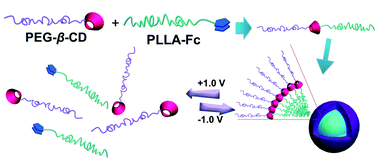In this paper, Yuan and co-workers reported on voltage-responsive micelles based on the assembly of two biocompatible homopolymers, namely; poly(ethylene glycol) homopolymer modified with β-cyclodextrin (PEG–β-CD) and poly(L-lactide) homopolymer modified with ferrocene (PLLA–Fc). Through host–guest interactions between β-CD and Fc, the two homopolymers connect together, forming a non-covalent supramolecular block copolymer PLLA–Fc/PEG–β-CD. PLLA–Fc/PEG–β-CD can further self-assemble to form stable micelles in aqueous solution. Through electrochemical control, a reversible assembly–disassembly transition of this micellar system was realized and voltage-controlled drug release based on this system was also conducted successfully using paclitaxel as the anticancer agent.
Voltage-responsive micelles based on the assembly of two biocompatible homopolymers by Liao Peng, Anchao Feng, Huijuan Zhang, Hong Wang, Chunmei Jian, Bowen Liu, Weiping Gao and Jinying Yuan Polym. Chem. 2014, 5, 1751-1759.
Julien Nicolas is a web-writer and advisory board member for Polymer Chemistry. He currently works at Univ. Paris-Sud (FR) as a CNRS researcher.











